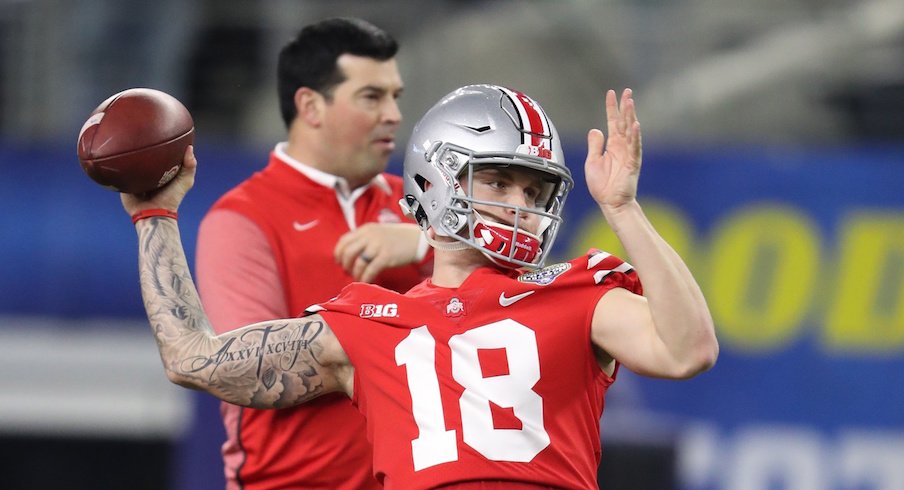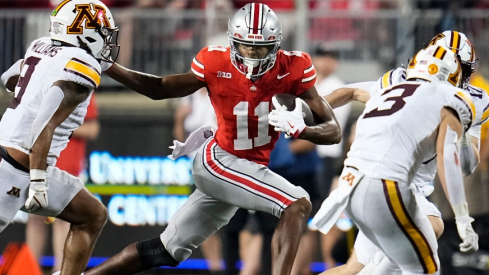Matthew Baldwin could be among the quarterbacks who sees the field for Ohio State in 2018.
No, you shouldn’t expect Baldwin to win the starting job. He almost certainly won’t be ahead of Dwayne Haskins or Joe Burrow or Tate Martell on the quarterback depth chart, regardless of what order those quarterbacks end up in. But if a proposed change to college football’s redshirt rules passes as appears likely this spring, the Buckeyes likely will find an opportunity to get the incoming freshman in a game at some point.
The American Football Coaches Association held its annual Football Bowl Subdivision head coaches’ meeting on Wednesday in Charlotte, N.C., where FBS coaches from throughout the country – including Ohio State’s Urban Meyer – came together to discuss potential rule changes and other issues surrounding college football. The biggest news to come out of the meeting was that a proposed rule change for redshirts, which would allow college football players to play as many as four games and still take a redshirt, was met with "unanimous" support, according to AFCA executive director Todd Berry.
"There was not a single dissention, two years in a row, against this," Berry said in a Wednesday press conference. "Very rarely will you find any coaching group, or probably any part of society, that is unanimous across every level … This needs to pass, and it needs to pass right now."
According to ESPN’s Adam Rittenberg, "the proposal will be presented to the NCAA later this month, and if it is allowed to proceed from there, it could be adopted by a vote in April, making the new rule effective for the upcoming season."
On the surface, the proposed new redshirt rule appears to benefit everyone, hence the lack of counterarguments and why it should be passed into law. It would allow teams to play more players over the course of the season without sacrificing a season of eligibility for those who only play in a few games. Most players would rather play even a little bit than not play at all for an entire season, but some would rather redshirt if it means preserving another year of eligibility for the future. The rule changes would make redshirting an easier decision, from both the coaches’ and players’ perspectives, for players who do not have a regular role on offense, defense or special teams.
“This needs to pass, and it needs to pass right now.”– AFCA executive director Todd Berry on proposed redshirt rule change
Meyer has often suggested that he seeks to avoid redshirting players, because many of the players Ohio State recruits are talented enough that they choose to leave for the NFL anyways before exhausting their eligibility. That suggestion held largely true this past season, when the Buckeyes redshirted only six of their 20 scholarship freshmen. Even so, though, there’s no question that the Buckeyes could benefit from this proposed rule change in the future.
While Ohio State only redshirted six players this past season, the Buckeyes likely would have redshirted more had this rule been in place. Wide receivers Trevon Grimes (who ultimately transferred to Florida) and Jaylen Harris each played in less than four games and would have been automatically eligible. Wide receiver/safety Brendon White, who appeared in only five games, likely would have redshirted too. Defensive tackle Haskell Garrett appeared in eight games, but considering he never took on a significant role in the rotation, he also could have been capped at four games to preserve another year of eligibility.
Ohio State did take advantage of the medical redshirt rule with at least one player this past season, running back Demario McCall, who is in line for a medical redshirt despite appearing in four games. Harris, who appeared in only three games before suffering an undisclosed injury of his own, could be another candidate for a medical redshirt. The proposed new redshirt rule, however, would simplify the process, as it would enable any player who played four games or less – provided that player hasn’t already taken a redshirt – to get another year of eligibility regardless of injury or when those games were played.
The proposed new redshirt rule could enable teams to play freshmen early in the season, particularly in games against lesser opponents, and evaluate their performance in game action before making redshirt decisions. On the flip side, it could also enable teams to activate redshirting players for bowl games or other late-season games as they develop over the course of the year.
No Ohio State redshirt would have benefited more from that rule this past season than Tate Martell, whose redshirt the Buckeyes actually considered burning when starting quarterback J.T. Barrett got injured against Michigan, according to offensive coordinator Kevin Wilson.
"We talked about it," Wilson said before the Cotton Bowl. "We had the situation with J.T.’s injury at the very, very end, where we were playing the rival game. And I think he would have wanted to play the one game if we needed him. And we’re like wait a minute now, that’s a whole year, because he would lose a year of eligibility if he plays in that game."
Ohio State decided not to play Martell in that game in order to preserve his eligibility, but the Buckeyes wouldn’t have had to make that decision under the proposed new rules. Additionally, the Buckeyes likely would have found a couple opportunities for him to play in blowout games earlier in the season, just to get him a little bit of game experience – experience that would certainly be valuable to have under his belt as he competes for the starting quarterback job in 2018.
Going forward, however, you can expect the Buckeyes to take advantage of the new redshirt rule – should it pass – in order to preserve future eligibility for more players while getting more freshmen on the field.
It shouldn’t make a big difference on who plays in the Buckeyes’ biggest games of the season – true freshmen who would be counted on to play in those games won’t be redshirting anyways – but it will enable the Buckeyes to play more of their young players in lopsided games without compromising their eligibility. Looking specifically at 2018, it could enable a player like Baldwin – who will almost certainly redshirt, as long as the quarterbacks in front of him on the depth chart stay healthy – to play even a few snaps in a few games, which could beneficial to both his development for the future and for his state of mind.
"The redshirt year for a student-athlete is the hardest year. They’ve got all kinds of data that basically states emotionally, it’s the most difficult," Berry said. "If all of a sudden, that young person is engaged that whole season, going you know what, I might have a chance to play … you’re going to have a chance to play and it’s going to be awesome, and once they get out there, they’re going to see it and they’re going to crave it even more. And they’re going to try to do well academically, and they’re going to try to do well socially, because they want to have that experience again. That’s a great thing."


